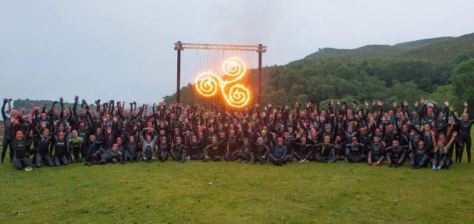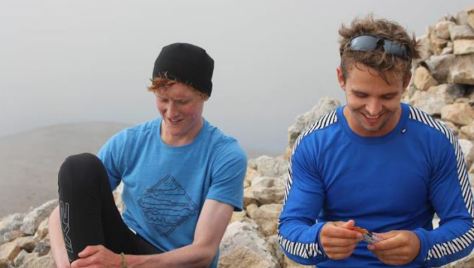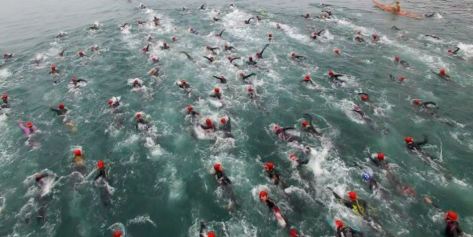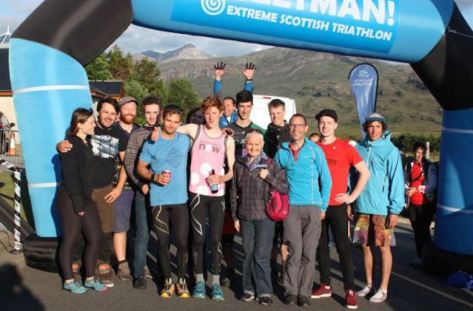University of the Highlands and Islands Gaelic Officer, DJ MacIntyre, describes taking part in a Hogmanay tradition as a child on the island of South Uist.
“I remember to this day the feeling of freezing rain blinding me and the extreme cold wind causing my ears to hurt. However, that did not bother me at this time. What was the occasion? Well, this was Hogmanay and the boys of the township were carrying out the traditional ritual of going from house to house on this special evening. What is the tradition behind it? It is widely thought that some of these island traditions came from the Vikings who were settlers in the Western Isles in particular, during past times. To be honest, that did not matter to me. I was out and about having fun.
This traditional event which happened in the Uists throughout the centuries, was also practised in many other places, but with differences in format depending on where you lived.
On these nights it was the young males that went round the township with permission given to boys as young as 5 to go out with the big boys. The upper age limit was normally 17.
 My township was North Boisdale and I would say there were about 25 houses to visit and a few not so friendly dogs to dodge! The start time was 7pm and all the boys would meet up at one end of the township and begin to visit each house on route. Each person had a pillow case or bag that would be filled with goodies received from householders. As you walked between each house the boys would shout in Gaelic “Hogmanay and New Year Hooray”. This alerted the folk, especially on a clear calm night, that the Hogmanay boys were on their way.
My township was North Boisdale and I would say there were about 25 houses to visit and a few not so friendly dogs to dodge! The start time was 7pm and all the boys would meet up at one end of the township and begin to visit each house on route. Each person had a pillow case or bag that would be filled with goodies received from householders. As you walked between each house the boys would shout in Gaelic “Hogmanay and New Year Hooray”. This alerted the folk, especially on a clear calm night, that the Hogmanay boys were on their way.
Outside each house one person would recite the Hogmanay poem and at the end of the poem ask the man of the house for permission to enter. Once inside the house a candle would be lit by the senior/eldest boy in the group and then the candle would be passed round all family members starting with the householder. There was superstition involved with this as it was thought that when the candle was being circled above each individual’s head, if the candle was to go out it meant that individual would have a year of bad luck. Of course jokers within the family would try and blow the candle out when this was taking place!
 Once every member of the family had been passed the candle, the mother of the house would bring out the gifts. Loafs of bread, sugar, fruit, biscuits and of course sweets. Sometimes folk would offer meat or fish. The man of the house would give money as would older males in the family. Older men in the township would offer a dram to the senior boys, which would of course be refused.
Once every member of the family had been passed the candle, the mother of the house would bring out the gifts. Loafs of bread, sugar, fruit, biscuits and of course sweets. Sometimes folk would offer meat or fish. The man of the house would give money as would older males in the family. Older men in the township would offer a dram to the senior boys, which would of course be refused.
On leaving each house the oldest boy in the group would wish luck on the family for the coming year.
After being to each house the pillowcases would be full and heavy and it was at the last house that the fun began. The pillowcases would be emptied and the goods shared out evenly. It did not matter how old you were the boys all got their share. The hosting house would also provide a small party that would finish before midnight so all the boys were home before the bells.
On the way home the blinding rain or freezing conditions did not bother me as I now had a pillowcase full of goodies, a full belly, and money in my pocket. A great start to the New Year!”
Links with Norse tradition
 Dr Ragnhild Ljosland, a lecturer at Centre for Nordic Studies in Orkney, confirms the Hogmanay Boys tradition has connections to Norse culture. She explains:
Dr Ragnhild Ljosland, a lecturer at Centre for Nordic Studies in Orkney, confirms the Hogmanay Boys tradition has connections to Norse culture. She explains:
“As a child in Norway in the 1980s, I remember dressing up to “gå julebukk” (go Yule-goating). Julebukk involves putting on a mask and going to people’s doors to chase Christmas out around New Year. You sing and carry a sack to collect cakes and sweeties – ah, the joy of ending up with a huge sack of goodies!
“If we go a couple of hundred years further back in time, Norwegian people used to walk in a group around the farms in the parish, dressed up so that nobody would recognise them. These costumes could be rather frightening and represent fantastical animals, such as an effigy of a billygoat’s head on a stick. The guisers would be offered food and drink at each farm.
 “These customs are extremely old, going back to pre-Christian beliefs. Folk belief had it that supernatural beings were extra active at this time of year. Interestingly, similar traditions are also found in Iceland, the Faroes, Shetland and Orkney. In Shetland today, for example, guisers travel around and are offered food and drink at Up Helly Aa in January.”
“These customs are extremely old, going back to pre-Christian beliefs. Folk belief had it that supernatural beings were extra active at this time of year. Interestingly, similar traditions are also found in Iceland, the Faroes, Shetland and Orkney. In Shetland today, for example, guisers travel around and are offered food and drink at Up Helly Aa in January.”







 Sam with his support runner Joakim
Sam with his support runner Joakim Photo by Steve Carter (stevecarter.com)
Photo by Steve Carter (stevecarter.com)

 Joakim (blue t-shirt) and Sam (vest top) with friends and family at the finishing line
Joakim (blue t-shirt) and Sam (vest top) with friends and family at the finishing line










